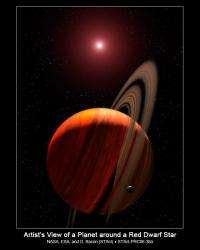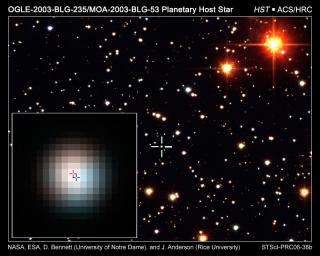Hubble Identifies Stellar Companion to Distant Planet

NASA's Hubble Space Telescope has for the first time identified the parent star of a distant planet discovered through gravitational microlensing.
Microlensing occurs when a foreground star amplifies the light of a background star that momentarily aligns with it. The particular character of the light magnification can reveal clues to the nature of the foreground star and any associated planets. However, without conclusively identifying and characterizing the foreground star, a unique determination of the properties of the accompanying planet is difficult.
Hubble's sharp vision is ideally suited to identify the parent star, or "host star," for planets found in our galaxy through microlensing. The leader of the Hubble team, David Bennett of the University of Notre Dame, Ind., said "the identification of the host star is critical for a complete understanding of the planets discovered by microlensing."
The newly discovered host star, catalogued as OGLE-2003-BLG-235L/MOA-2003-BLG-53L, has a planet companion that was discovered in 2003 through ground-based gravitational microlensing observations. This technique takes advantage of the random motions of stars, which are generally too small to be noticed without precise measurements. If one star, however, passes precisely (or nearly precisely) in front of another star, the gravity of the foreground star acts like a giant lens, magnifying the light from the background star.

A planetary companion around the foreground star can produce additional brightening of the background star. This additional brightening can reveal the planet, which is otherwise too faint to be seen by telescopes. The duration of the microlensing event is several months, and the extra brightening due to a planet lasts a few hours to a couple of days. The ground-based microlensing data had indicated a combined system of foreground and background stars plus a planet. However, it took the acuity of Hubble to discern in the light from the foreground and background star by making follow-up observations two years after the microlens event. This allowed for a definitive determination of the characteristics of the planet's parent star.
The sharp Hubble images allowed the research team to separate out the background source star from its neighbors in the very crowded star field in the direction of the center of our galaxy. The star appeared to be about 20 percent brighter than expected. This additional brightness is most likely from the foreground lens star, which hosts the planet. Although the Hubble images were taken nearly two years after the lensing event, the source and lens stars were still so close together on the sky that they essentially appeared as one star.
Nevertheless, Hubble observations were precise enough to distinguish the slight offset in the positions of the two stars. Hubble can't resolve the two stars, but, by taking multiple images through different colored filters, Hubble's Advanced Camera for Surveys can record a color offset in the overlapping light of the two stars. This is possible because the foreground star is a different color from the background star. At present, the foreground star is offset by 0.7 milliarcseconds (the angular width of a dime seen 3,000 miles away) from the background source star. Follow-up observations with Hubble in the coming years should reveal an increasing gap between the foreground and background stars.
Researchers noted that the newly discovered host star is more massive, and therefore hotter, than expected for a random field star in our galaxy. It is 63 percent the mass of the Earth's sun, while the average star has only 30 percent of the sun's mass. The host star identification also enabled the determination of its distance at 19,000 light-years and the planet's mass of 2.6 Jupiter masses. The characteristics of the lensing event show that the planet is in a Jupiter-sized orbit around its parent red star.
Understanding the types of host stars around which remote planets orbit is fundamental to improving theoretical models of planet formation. The popular core-accretion model predicts that giant planets grow from small rocky seed objects in a disk of debris around a star. Since more massive disks are expected around more massive stars, it follows that gas giant planets will rarely form around low-mass stars.
The Hubble observations are consistent with the core accretion model, especially if additional future microlensing detections of other star-planet systems continue to reveal massive host stars for gas giant planets.
Source: Space Telescope Science Institute




















